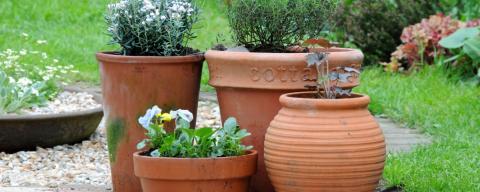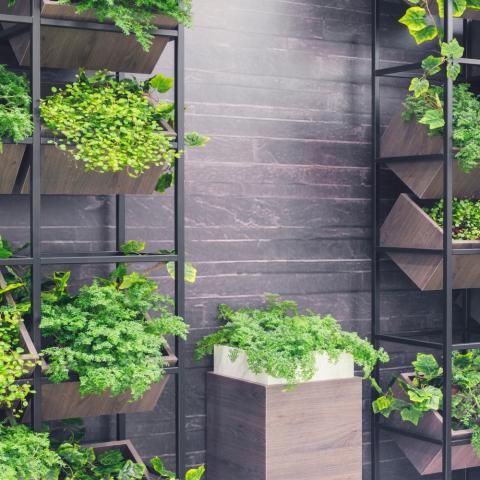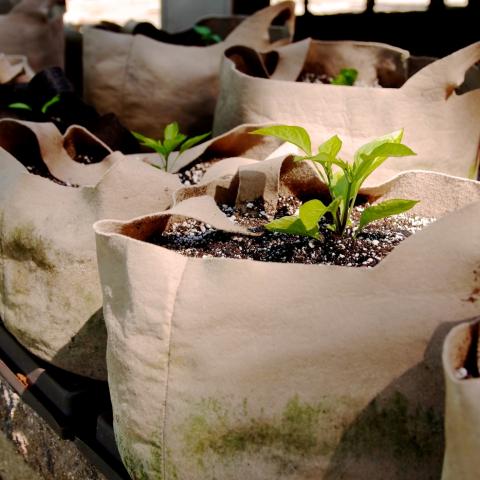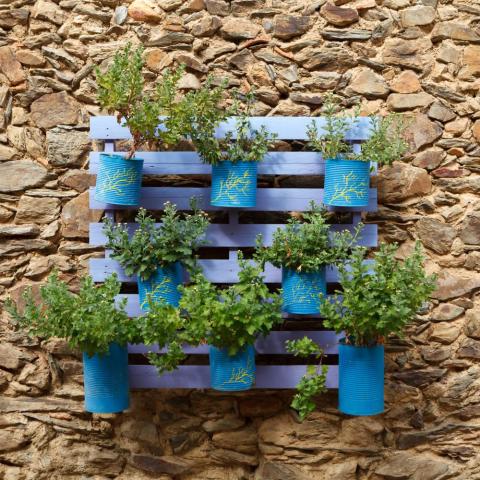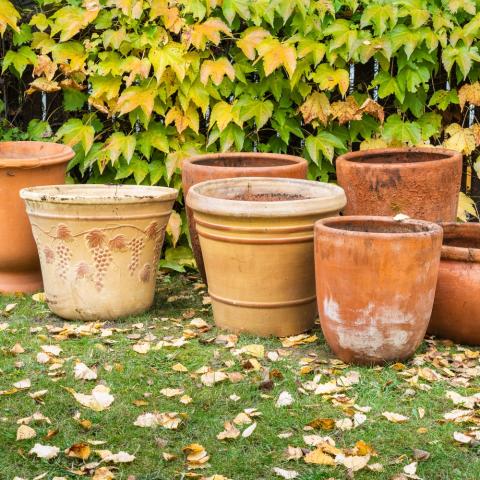Tips for Small Space Gardening - Pots and Other Containers
If you don’t have the space to garden in the ground and building raised beds is not an option for you either, don’t fret! You can still have a very productive annual or perennial garden by growing in containers. One of the best advantages of growing in containers is that you can move your garden around as the seasons change and as your plants go through their lifecycles. Containers can be placed on the ground, on a stoop, on a balcony or porch or, if you have a DIY spirit, you could even try your hand at vertical gardening!
If you choose to grow in containers, there are some basic things you need to be aware of for this specific type of gardening.
Container material
You can grow in many types of containers. The materials of pots can vary greatly as do the characteristics of those materials as they relate to plants. Ceramic, glazed ceramic, plastic, wood and felt are all common materials for containers. Ceramic and felt are porous, which will allow for air exchange between the growing media (potting mix) and the outside environment. This is great for certain plants that are susceptible to root rot, but your growing media could dry out faster so you may have to water plants more. Glazed ceramic and plastic containers will hold onto moisture better so those will be more appropriate for plants that like a moist environment.
Container size
The size of the container is a very important factor in whether container plants are successful or not. Problems often arise when containers are too small for the plants grown in them. It’s easy to overload a container if you plant too many small seeds and don’t thin them out or if you plant too many transplants when they are still small. We recommend reading up about how big your plants can be expected to be at maturity and how much space they need. You don’t want your plants to shade each other out and compete for limited nutrients. When plants are grown in containers that are too small, the roots will get “bound” and wrap around the inside, looking for more room.
Too little space could lead to the soil drying out too quickly as well. As an example, most tomato plants will require at least a five-gallon container to thrive. There are some varieties that have been bred to be more compact but generally plants like this need plenty of room to be successful. If you know that you’ll be gardening in containers but still want a good variety of vegetables, consider trying to find “bush” or “dwarf” varieties that will have a smaller growth habit.
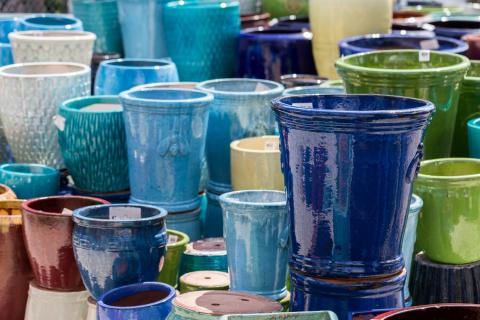
Growing media
The best growing media for pot-sized containers will contain no soil at all. Your typical garden topsoil is far too dense to allow plants in small spaces to properly drain, grow their root systems and get enough oxygen. For growing in pots, you really want a light, fluffy mix that will hold onto moisture, air and nutrients but also be able to drain sufficiently when watered to saturation or when it rains for an extended time. We recommend using a commercially available 100% soilless mix, a blend of 1/3 compost, 2/3 soilless mix or use our simple recipe below to make your own soilless mix. Topsoil and compost are both quite heavy and dense (especially when wet) and therefore not generally appropriate for making up any more than a third of the total material in containers smaller than a raised bed. Soilless mixes contain peat moss or the more sustainable coconut coir (made from shredded coconut husk) as the main structural ingredient with the addition of sand for drainage and perlite or vermiculite for the ability to hold onto water and oxygen.
Fertilizing plants in containers
Due to the small size of most containers versus gardening in the ground, along with the fact that you’re likely not using any actual soil in your containers, you’ll have to fertilize your plants more often because the plants won’t have access to the nutrients typically found in topsoil. A good quality compost will contain some nutrients but will need to be supplemented to give plants everything they need throughout the season. Use a balanced conventional water-soluble or controlled release fertilizer or a solid or liquid organic fertilizer found at garden stores for your container garden. Many of these will have instructions for use for containers specifically. You should tailor your fertilizer for the types of plants grown as well as where your plants are in their lifecycle (seedling stage, flowering, fruiting, etc). Have a look at this UNH Extension resource titled, “Using Fertilizers and Potting Soil to Grow Plants” and be sure to follow the directions on your fertilizer’s label.
DIY soilless potting mix
Equal parts
- Peat moss or coconut coir
- Quality screened compost
- Perlite or vermiculite
Growing perennials in pots
Small container gardening is certainly not limited to growing annuals. Just like if they were in the ground, many perennials will go into dormancy once the weather gets cold. With the right-sized container, dwarf trees and shrubs, perennial flowers and fruiting plants such as figs, strawberries and even blueberries can also be grown in pots! If the plant is deciduous (meaning they lose their leaves in the fall), keep them outdoors until it begins to dip into freezing temperatures, and they drop their leaves. Then you can bring them into an unheated garage, shed basement or other protected space for the winter. While dormant, the plant’s water use will drastically slow down, but you still want to make sure the growing media doesn’t completely dry out so check on your plants once and a while and water as necessary. When the temperature begins to climb again, bring the plants back outside and watch them wake up and grow!
Indoor growing (windowsill, artificial light)
If you are short on outdoor space, it is still possible to grow a small garden in containers inside your home. For some plants, a bright, south-facing window is all that’s necessary. For other plants, especially those that require full sun (which is six or more hours of direct sunlight per day), you may need to use supplemental lighting. Fluorescent bulbs have been the traditional light source for indoor growing and seed starting but LED bulbs are becoming more available and popular due to their high level of efficiency. To help you figure out what type and how much light you need, have a look at this article from the University of Vermont Extension titled, “Tips for Choosing Grow Lights.”
If you want more information about growing a container garden, please have a look at the resources on the UNH Extension Yard and Garden website or reach out to the UNH Extension Infoline to talk to one of our Master Gardener Volunteers. Our phone number is 877-398-4769, and our email address is answers@unh.edu.
Do you love learning about stuff like this?
SUBSCRIBE TO Granite State Gardening newsletter
Got questions? The UNH Extension Yard and Garden Infoline offers practical help finding answers for your yard and garden questions.
Call toll free at 1-877-398-4769, Monday to Friday, 9 a.m. to 2 p.m., or fill out webform.
